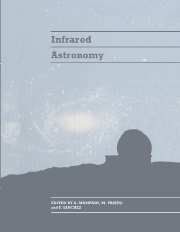Book contents
- Frontmatter
- Contents
- List of Participants
- Preface
- 1 Star Formation
- 2 Last Stages of Stellar Evolution
- 3 The Milky Way Galaxy and the Galactic Centre
- 4 Galaxies in the Infrared
- 5 Cosmology
- 6 G25.2+0.2, a New Ring Nebula Around a Luminous Blue Star: Case Study for the Importance of IR Observations
- 7 Two Colloquia on Cosmic Dust
- 8 Infrared Instrumentation
- 9 Infrared Astronomy with Satellites
2 - Last Stages of Stellar Evolution
Published online by Cambridge University Press: 23 December 2009
- Frontmatter
- Contents
- List of Participants
- Preface
- 1 Star Formation
- 2 Last Stages of Stellar Evolution
- 3 The Milky Way Galaxy and the Galactic Centre
- 4 Galaxies in the Infrared
- 5 Cosmology
- 6 G25.2+0.2, a New Ring Nebula Around a Luminous Blue Star: Case Study for the Importance of IR Observations
- 7 Two Colloquia on Cosmic Dust
- 8 Infrared Instrumentation
- 9 Infrared Astronomy with Satellites
Summary
THEORETICAL EVOLUTION
In order to discuss the observations in a meaningful way, it is useful to first discuss the theory, because only then does one have a meaningful context in which to place the observations. One must note that this does not imply that the theory is well understood, because this is not necessarily the case. But this approach gives some insight as to what the key observations are, and by comparing the observations with the theory one can find the weakness in the theory which can be more thoroughly studied.
Review of the early evolution
The main sequence star transforms hydrogen into helium in the central regions of the star as its source of energy. This stage is usually referred to as hydrogen burning. As the hydrogen burns, the core gradually contracts and heats up, which produces an increase in the rate at which the hydrogen is burned. The increased burning rate closely offsets the diminished fuel supply, and the luminosity of the star does not change substantially. For the first 90% of its lifetime the star remains close to the main sequence, and may double its luminosity in this time. This is shown schematically in the H-R diagram, Fig. 1, as the motion from points A to B. The initial position on the main sequence is determined only by the mass of the star, as long as it consists mainly of hydrogen. Evolutionary tracks are shown for stars of 1.1 M⊙ and 5 M⊙. The former represent the ‘low’ mass stars and the latter represent ‘intermediate’ mass stars which will be presently more completely defined.
- Type
- Chapter
- Information
- Infrared Astronomy , pp. 63 - 122Publisher: Cambridge University PressPrint publication year: 1994



